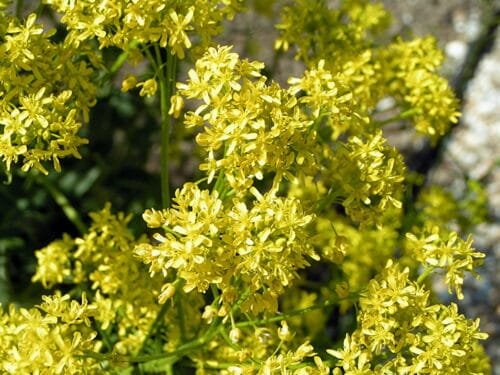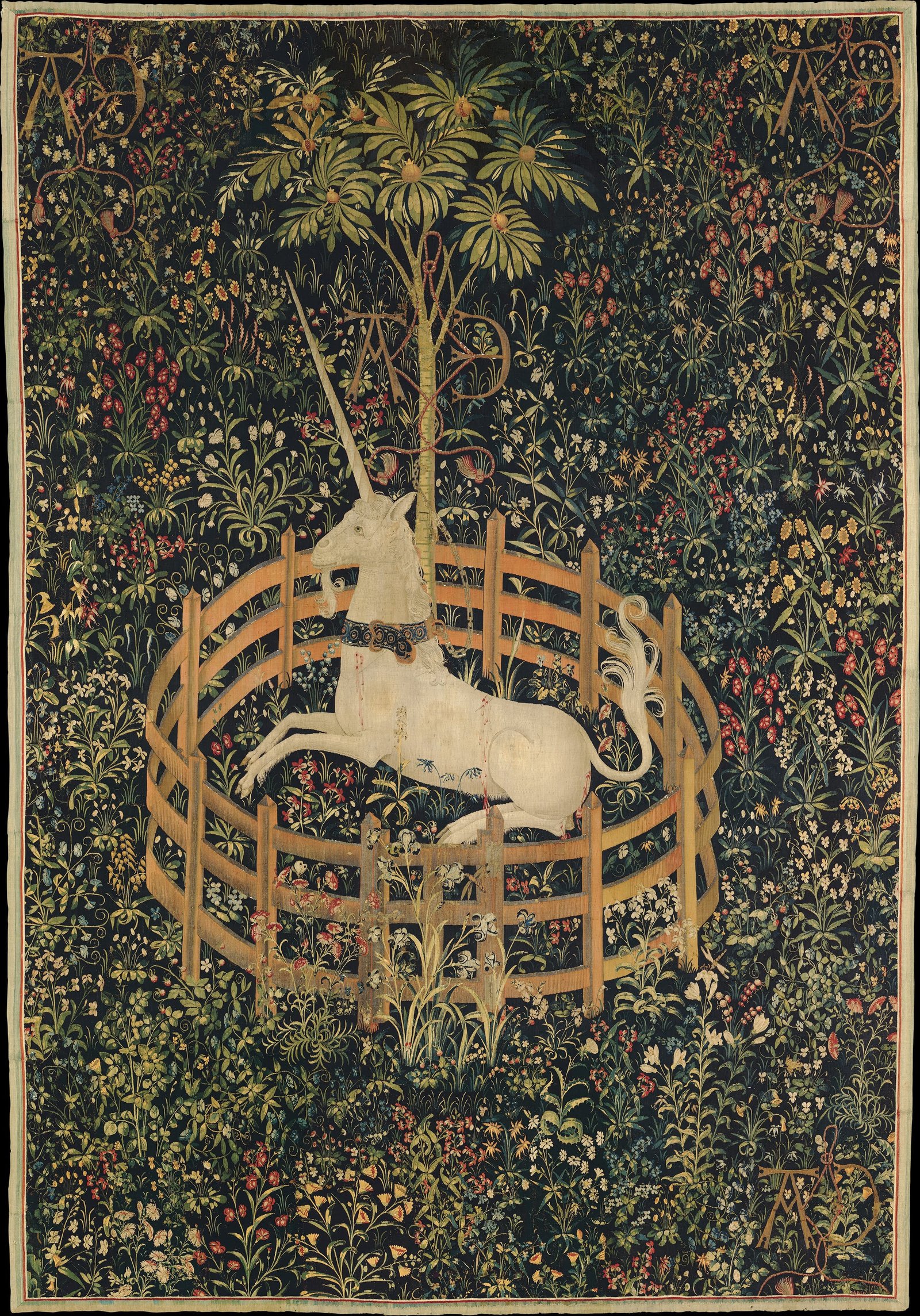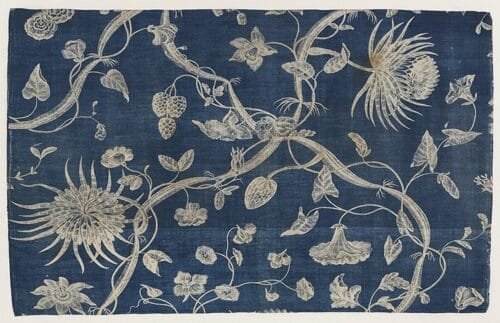Blue Dyes

Unlike blue pigments, blue indigo dye was far more accessible in the ancient world and to the common man.
The Romans imported cheap indigo blue dye, making blue the color of working-class clothing, with colors like black, red or violet worn by the nobility. (White was also a color worn by the wealthy, but that was because of the upkeep it required.) Blue was also considered a color of mourning, and the color of barbarians.

Celts and Picts and Germans were said to have dyed their faces blue to frighten their enemies, and tinted their hair blue when they grew old. In England indigo dye was used to color clothing worn by men and women of all social backgrounds.
The earliest European source of indigo dyes was woad.
Woad
The flowering plant Isatis tinctoria, also called woad, glastum or Asp of Jerusalem grows throughout Europe, especially Western and Southern Europe Its leaves produce a distinct blue indigo dye. Woad growing regions in medieval England, Germany and France became prosperous from the woad trade.

Woad (blue), along with madder (red) and weld (yellow), was one of three staple dyes of the medieval European dyeing industry. Tapestries like The Hunt of the Unicorn series (1495-1505) feature fibers dyed with woad. A woad-based ink was also used to illustrate medieval manuscripts.
Indigo from other sources.
Indigo is the dye chemical extracted from woad. Interestingly, the same dye can be extracted from another plant, sometimes called “true indigo”, Indigofera tinctoria. “True indigo” produces the dye in higher concentrations than the woad plants prevalent in Europe. As far back as 4000 BC, evidence for use of this color can be found in Peru. True indigo plants were also cultivated in East Asia, Egypt and India.
Indigo disrupts the textile trades

After the Portuguese discovery of a sea route to India in 1498, indigo (from true indigo) began to be imported from Asia. The better colorfastness of imported indigo made it a serious competitor in the blue dye market. By 1577, governments began to intervene by denouncing imported indigo as damaging and even going to far as to prohibit its use. Even so, indigo was a highly desired import during the 17th and 18th centuries. The dye drove trade wars between European nations and the Americas, fueled the African slave trade, and even partially funded the American Revolutionary war.

Indigo in the spectrum
Astute readers will recognize ‘indigo’ as one of the colors of the ROYGBIV spectrum developed by Sit Isaac Newton. Less well known are the reasons for indigo’s inclusion in the spectrum. It seems Newton believed that since there were seven days in the week, seven known planets (at the time), and seven notes on the (western) musical scale, there should also be seven colors in the spectrum. Never mind the annoying little fact that there only seemed to be five unique colors, Newton pushed orange and indigo into the spectrum to achieve his desired seven colors.
Synthetic indigo
German chemist Von Baeyer developed a synthetic indigo in 1878. By the end of the WWI, the synthetic product had replaced natural indigo and brought an end to the natural indigo trade from the East and West Indies. In 1901, Indanthrone blue, another synthetic indigo, which had greater fade resistance, captured the market. Today nearly all blue jeans are dyed with this product.
But that may not be true for much longer. Scientist have engineered an Escherichia coli bacteria to produce the chemical reaction that creates natural indigo. Called “bio-indigo”, it could be the next, environmentally friendly, chapter in the story of indigo and the history of blue.
References
Campbell, Robert. The London Tradesman: Being a Compendious View of All the Trades, Professions, Arts, Both Liberal and Mechanic, Now Practised in the Cities of London and Westminster. Calculated for the Information of Parents, and Instruction of Youth in Their Choice of Business. T. Gardner. London. 1747.
Gottesman, Sarah. The 6,000-Year History of Blue Pigments in Art. Artsy. November 29, 2016 Accessed April 25, 2021 https://www.artsy.net/article/artsy-editorial-a-brief-history-of-blue
Kane, Katheryn. Regency Colormen. Regency Redingote. September 30, 2011. Accessed April 23, 2021. https://regencyredingote.wordpress.com/2011/09/30/regency-colormen/
Michaeli, Dov. A Brief But Powerful History of the Colors Purple and Blue . The Doctor Weighs In. February 9, 2021. Accessed April 26, 2021 https://thedoctorweighsin.com/history-purple-blue/
Taggart, Emma. The History of the Color Blue: From Ancient Egypt to the Latest Scientific Discoveries. My Modern Met. February 12, 2018 Accessed April 21, 2021 https://mymodernmet.com/shades-of-blue-color-history/
The Color Blue: History, Science, Facts. Dunned Wards. May 12 2015. Accessed April 19, 2021 ttps://www.dunnedwards.com/colors/specs/posts/color-blue-history
The History and Meaning Behind the Color Blue in Art. Invaluable. December 7, 2018 Accessed April 15, 2021 https://www.invaluable.com/blog/blue-color/
The History Of The Colour Blue . London Fine Arts. August 28 2018. Accessed April 20, 2021 https://londonfineartstudios.com/the-history-of-the-colour-blue/

This is absolutely fascinating! Newton responsible for ROYGBIV because of his focus on the number 7 is intriguing. I shall have to look more closely at a rainbow and see if I can find any justification for this Newtonian conviction. After all, one tends to find what one seeks to prove one’s own biases. Most important, however, the name, The Blue Order, might be rooted in woad, leafing out for the protection of all England (and Scotland and Wales and Ireland in spite of the ruthless wars of greed, ego and conquest that led to the formation of Great Britain?) from the horrors of dragon war and unending war between humans and dragons. It will be most interesting to learn more of the true blue history of the name of that peace-making organization. Thank you, Maria Grace, for this summary of your intense research. Who knew there was so much to learn about blue?
I didn’t realize Newton created the acronym for the color spectrum. Your research point about the Celts reminded me of that movie Braveheart. William Wallace [Mel Gibson] and his Scottish forces painted their faces blue. This has been so interesting.